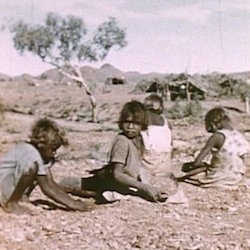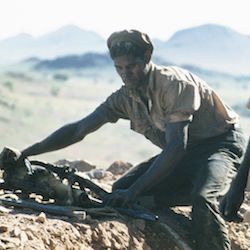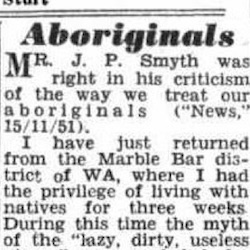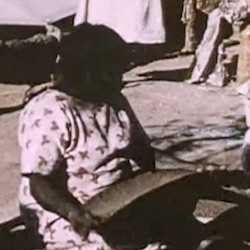The physical anthropologist Norman B. Tindale spent three months with the mining community in 1953 as part of the University of Adelaide and University of California Anthropological Expedition of 1952-54. He recorded details of the group’s mining activities in his journal.
Norman Tindale Writes on Mining Activities
p. 241, 5 MAY 1953 At Pigangoora. … Went with … Ernie Mitchell (Njamal tribe) to see several other camps. We are at Bore Camp, a couple of miles north along the range is the Rockhole Camp, and six miles away in the same direction, the Pilgangoora Well Camp. The well was dug by the aborigines and is fitted with a weighed whip. It is about 15 feet deep, it nearly gave out during the last dry spell but is now yeilding well. The water is good. We carried water and firewood back to camp. In the afternoon we talked with people and watched them mining for columbite. They dig into old creek bed deposits 3 to 4 feet deep and take the six inches or so of alluvial above bed rock, dry it on swept places on the bank, then winnow it to remove dust, yandy it in wooden or more often metal dishes, shaped like their old wooden dishes. Two dishes full of original dirt, yandied can produce ¼ of a beef tin full of columbite if on ‘good dirt’.
p. 271, 7 May
In the evening Don and Des Stuart paid a visit to our camp so not much working was done. Learnt that 1 fruit tin of columbite is a days work for each member of a team of four working a patch. One digs out the ore, another carries it, picks it over, rubbing it between [boards?] to loosen composite pieces. The yandy person, often a woman, cleans and separates the ore. Saw people at work during the afternoon.
p. 481, 10 June 1953, Kulikuli Creek (Turkey Creek)
Watched the camp group at Kulikuli cleaning columbite. The material brought from the field and handed in by the work gangs is washed, dried and yandied to get out the dross, then has a magnet drawn through it taking out about 40% of the iron. Further picking over for extraneous particles is done and the material bagged for export. With a little practice it is possible to pick out individual crystals and rolled crystals of rather shiny columbite as distinct from the very dull matte iron particles of similar size and shape.
p. 487, 12 June 1953, Kulikuli camp.
For the 40 odd people at Kulikuli there are thirteen huts and tents arranged in two lines, one store tent, the head man’s bush shelter to one side. The arrangement of bush huts is not controlled by class but there are two sessions at meals so that men and their mothers in law can keep apart. Meals are called by ringing a stock bell. There is breakfast at sunrise, a noon day meal at 12:30 and an evening meal at sunset. There are two work gangs which go out for columbite; each has twelve members. They gather daily 10-14 fruit cans of cleaned ore containing iron. This is cleaned and the iron removed by by magnet which reduces the bult to about 60%, sometimes to 40% of clean columbite. A work force of 5-6 works every day for about 5-6 hours cleaning the product ready for bagging. The camp has been going for nearly two months. The three main water pools are permanent.
When, as on one afternoon, after columbite cleaning was finished, old ladies came and worked over the ground … the work spot, picking up scraps of ground and working it, obviously because it was easier to play at working than to do nothing, just like a party of women knitting for something to do. Returned to Pilgangoora Well.
Today saw an interesting crystal form of columbite in the work camp & was given it for the collection.
Citation
Norman B. Tindale, extracts from journal ‘University of Adelaide and University of California Anthropological Expedition, 1952-1954’, South Australian Museum, AA 338-1-19-1, 241, 271, 481, 487.






